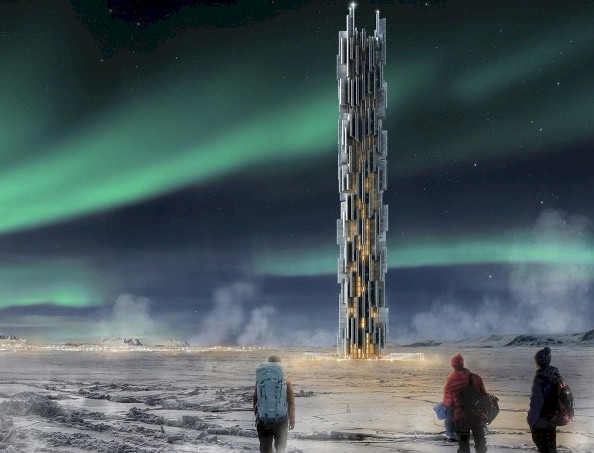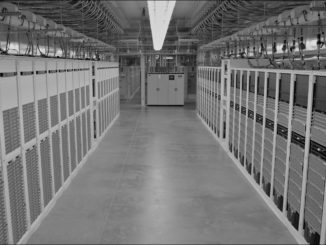
We talk about architecture all the time when discussing systems, but when it comes to the datacenters that house these machines, the shells are about as exciting as a monstrous warehouse for a massive distribution operation. Considering that data and processing are the most profitable products on the planet these days, maybe this is suitable and fitting, but another way to look at it is that datacenters should not only be marvels of engineering but also inspiring structures like other kinds of buildings.
Every year, the architecture magazine Evolo hosts a skyscraper design competition so that architects can let their designs soar and go a little crazy, and the third place winner in the contest this year went to Valeria Mercuri and Marco Merletti, who proposed a sustainable skyscraper located in Iceland called the Data Tower that looks like something straight out of sci-fi.
Datacenters often do go vertical, and whether you know it or not, the skylines of most major cities already have data skyscrapers. Here is a famous one in New York City, which has been used in numerous sci-fi shows (including the Buck Rogers televison show):
Built in 1974, this building at 33 Thomas Street in Lower Manhattan was a long distance switch center that had three humongous switches for long distance telephone exchanges – the AT&T network had 145 of these beasts across its network in the United States. If you see a big building with no windows and lots of vents downtown in your city, perhaps with an AT&T or Verizon logo on it, this is a giant telecom datacenter that is vertical instead of horizontal.
The futuristic datacenter design by Mercuri and Merletti, which was bested by a proposed project to dig Central Park in New York City down to the bedrock and install a perimeter of 1,000-foot skyscraper around it as well as another skyscraper called The Hive that is a central control terminal for drones coincidentally also located in New York City, beat out another 485 proposed skyscraper projects to win its third place. Take a look at the Data Tower:
The idea is to go vertical rather than horizontal with the datacenter and make use of natural cool air flows as well as geothermal energy sources by locating it in Iceland, where both are plentiful. The idea is not to just use a hollow cylinder with servers and storage as the skin of the building, with the machinery essentially creating its own chimney and airflow to cool itself, but to use cylindrical and hollow 3D motherboards with memory, storage, and networking components snapped onto the outside and a small fan on the inside to pull outside air over the components and then move it to the empty center of the Data Tower. The idea is to take all of this heat and recycle it for the ring of greenhouses and laboratories located at the base of the facility.
To construct the Data Tower, pods of computing equipment are mounted on 24 pillars that make up the exoskeleton of the building, which can be raised in height as the datacenter needs to add capacity. The pods, which you see jutting out of the Data Tower, also grow in capacity, ranging in size from four to eight standard racks in size. The pods in the facility are movable, so when they need to be expanded or machines need to be repaired in some fashion, a pod can be
At 300 meters tall, Mercuri and Merletti reckon that a Data Tower could host up to 400,000 servers. Generally speaking, hyperscalers do not like putting that much machinery in one place, so they might be more inclined to use a series of smaller towers with unique power and network feeds on smaller Data Towers. Getting the networks to Iceland might be an issue, but local power should not be. A 50 meter facility would house about 65,000 servers, which is about the right failure domain for most hyperscalers and cloud builders for a datacenter in one of their regions.
The design did not get into the specifics of what the power usage effectiveness, or PUE, of the datacenter would be, but presumably given the free air cooling and the fact that the servers and storage are on the skin of the tower and therefore have much more contact with the air surface than in a modern, essentially 2D datacenter (which has to move the air across hundreds of thousands of square feet of space), we would expect that the PUE would be very close to 1.0. With the recycled heat being taken into account and the basically free geothermal energy source in Iceland, this could be a very efficient datacenter indeed.








I love beautiful architecture, but some of the best datacenter facilities are underground or in heavily shielded basic boxes for good reasons.
Shielding against natural or manmade EMP, space weather and eavesdropping make underground, inside a mountain or flat the best choices, and many of those secure facilities are quite beautiful on the inside.
The aurora in that picture is beautiful, but the terrestrial effects of space weather and air showers(the cosmic ray ones, not the dust cleaning ones) is something computers have to be shielded against.
Its something that datacenter or supercomputer center designers really need to take into consideration, but they sometimes don’t go beyond basic EMC.
The most secure facilities have excellent EMP protection and EMC by design, so hopefully something so critical to a datacenter’s design isnt being overlooked in favor of passive cooling and “eco friendliness”. Although if the servers are “on the skin of the tower” I doubt they would be well hardened.
I also wonder how thick the structural elements and walls of a building that tall, designed to be packed densely with racks that can weigh over a ton each would need to be, and how much space for hardware that eats up.
To me, it would make a lot of sense to use all that icy water in the picture for cooling with a liquid to liquid heat exchange design, rather than air cooled cylindrical motherboards which would require massive expenses just to make them work, let alone work well. I cant imagine how the sockets would be integrated and wire traces done without timing and antenna issues all over the place.
This “Data Tower” concept is interesting – but not original. Its basically the concept of the Mac Pro – on a gigantic scale.